Autonomic laterality in caloric vestibular stimulation
Mohammadreza Aghababaei Ziarati,Mohammad Hosein Taziki,Seyed Mehran Hosseini
Abstract BACKGROUND Caloric stimulation of the vestibular system is associated with autonomic response.The lateralization in the nervous system activities also involves the autonomic nervous system.AIM To compare the effect of the right and left ear caloric test on the cardiac sympathovagal tone in healthy persons.METHODS This self-control study was conducted on 12 healthy male volunteers.The minimal ice water caloric test was applied for vestibular stimulation.This was done by irrigating 1 milliliter of 4±2 °C ice water into the external ear canal in 1 s.In each experiment,only one ear was stimulated.For each ear,the pessimum position was considered as sham control and the optimum position was set as caloric vestibular stimulation of horizontal semicircular channel.The order of right or left caloric vestibular stimulation and the sequence of optimum or pessimum head position in each set were random.The recovery time between each calorie test was 5 min.The short-term heart rate variability(HRV)was used for cardiac sympathovagal tone metrics.All variables were compared using the analysis of variance.RESULTS After caloric vestibular stimulation,the short-term time-domain and frequencydomain HRV indices as well as,the systolic and the diastolic arterial blood pressure,the respiratory rate and the respiratory amplitude,had no significant changes.These negative results were similar in the right and the left sides.Nystagmus duration of left caloric vestibular stimulations in the optimum and the pessimum positions had significant differences(e.g.,72.14±39.06 vs 45.35±35.65,P<0.01).Nystagmus duration of right caloric vestibular stimulations in the optimum and the pessimum positions had also significant differences(e.g.,86.42±67.20 vs 50.71±29.73,P<0.01).The time of the start of the nystagmus following caloric vestibular stimulation had no differences in both sides and both positions.CONCLUSION Minimal ice water caloric stimulation of the right and left vestibular system did not affect the cardiac sympathovagal balance according to HRV indices.
Key words: Caloric stimulation;Heart rate variability;Vestibular system;Autonomic;Laterality
INTRODUCTION
The vestibular system provides sensory information for static and dynamic balance of the body.The physiological stimuli of the vestibular system are linear and angular accelerations.The effect of the vestibular system on the autonomic nervous system activity is generally called vestibulo-sympathetic reflex[1-5].It is also known as the vestibulo-autonomic reflex[6].A well-documented example of this reflex is the openloop feedforward control of blood pressure during orthostatic challenges[7-9].But any active or passive orthostatic challenges or body movements in addition to the vestibular system also stimulates a variety of mechanical receptors in the muscles and the cardiovascular system.These sensory signals are distributed in the brain stem and other parts of the central nervous system and may affect the autonomic tone[10-14].In order to eliminate these movement induced effects from vestibulo-sympathetic reflex,the vestibular system must be stimulated by non-physiological methods like sound,vibration,caloric test and galvanic stimulation[15-19].Caloric test is one of the most useful laboratory methods to determine the response of the labyrinth.It is also one of the few methods that allow the assessment of one labyrinth independent of the other[20-23].In vestibular epithelium the slow or type II sensory cells are more responsive to caloric test[24].The caloric test specifically stimulates the lateral or horizontal semicircular duct.There are two reasons for this phenomenon.The first reason is the closeness of this duct to the thermal stimulus in the outer ear.The second reason is the position of this duct in the same direction of thermal convections in the outer ear duct during caloric test.Vestibular stimulation in the caloric test has two mechanisms.One of them is a direct effect of temperature on vestibular afferents and/or receptors.This mechanism is independent of the head position and it matters less in quantity.The second and first-known mechanism is due to endolymph convection which is depended on the head position.The optimum position means the head is flexed 30 degrees forward in the supine position.This position puts the horizontal semicircular ducts in vertical or gravity plane.The pessimum position means the head is extended 60 degrees backward in the supine position.This position puts the horizontal semicircular ducts in the horizontal plane and eliminates the effect of gravity on endolymph convection(Figure 1).
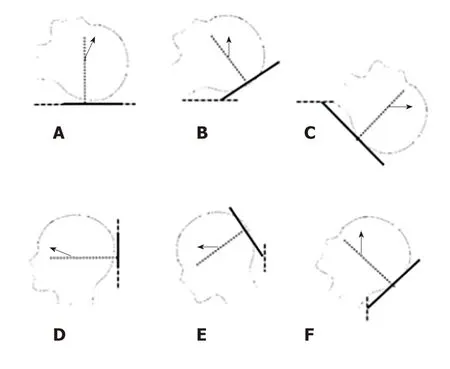
Figure 1 Schematic drawing of horizontal semi-circular canal axis and its alignment with gravity plane in supine and upright orientations. A:Arrow shows the angle between horizontal canal and vertical line in supine position;B:Arrow shows the vertical position of horizontal canal following the 30° forward tilt in supine position e.g.,the optimum position in supine state;C:Arrow shows the horizental position of horizontal canal following the 60°backward tilt in supine position e.g.,the pessimum position in supine state;D:Arrow shows the angle between horizontal canal and horizental line in upright position;E:Arrow shows the horizental position of horizontal canal following the 30° forward tilt in upright position e.g.,the pessimum position in upright state;F:Arrow shows the vertical position of horizontal canal following the 60° backward tilt in upright position e.g.,the optimum position in upright state.In optimum position the horizontal canal axis is vertical and in the gravity plane(B and F).In pessimum position this axis is horizontal and eliminates the effect of gravity on endolymph convection(C and E).
Caloric stimulation of vestibular system is associated with autonomic response[25-27].Similarly some of these autonomic effects are related to changes in skin temperature or the activation of other sensory afferents and are unrelated to stimulation of vestibular system[28].However,head positioning to some extent can unmask the vestibular from the non-vestibular or thermoreceptors-induced autonomic effect,at least theoretically.
The lateralization in the nervous system activities also involves the autonomic nervous system[29-31].In the review of available literature and databases,we cannot find any report about the autonomic laterality of the caloric test in normal participants.There are many reports about the differences in caloric test response parameters between right and left ear,for example,the duration and the time of onset or offset of nystagmus or the speed of its slow or fast phases.However,it is well documented that the caloric test may induce asymmetric stimulation and its output or the vestibulo ocular reflex has an inter-aural difference.The reasons for these asymmetric responses are generally attributed to the variation in the shape or in the size of external ear canals or middle ear as well as to the coplanarity of canals[32-36].
However,the lateralization may also play a role in caloric test outcomes including its autonomic effects.In this self-control study,we compared the effect of the caloric test on the cardiac sympathovagal tone in healthy persons in two states,the optimum and the pessimum positions,then the difference between the right and the left caloric vestibular stimulations on heart rate variability(HRV)were evaluated.
MATERIALS AND METHODS
This self-control study was conducted on 12 healthy male volunteers.The study protocol was confirmed by the research council of Golestan University of Medical Sciences.The ethic number was ir.goums.REC.1396.275.The subjects underwent the general clinical and otoscopic examination.They had no drug history.None of them were smokers.They had no history of chronic illness or hospitalization last year.All participants were informed about the study and assigned the informed consent.There was not any exclusion of the case from this study because of a closed ear canal,rigid ear wax,rupture of the tympanum,a history of Dizziness,vertigo,tinnitus,spontaneous nystagmus,deviation of the visual axis and eye movement disorders.All experiments were performed in the morning and between 10 h and 12 h.The volunteers were fasting at least 3 h before the experiment.The caloric test was performed in the supine position in a dim-light room.Each ear was tested twice,in forward or optimum and in backward or pessimum bending modes,as shown in Figure 2.The order of right or left ear vestibular stimulation was randomly assigned for each volunteer.The sequence of the forward or backward head bending for the caloric test was also randomly assigned for every volunteer.This was done to reduce the conditioning effect of the first caloric test experience on the results of the next caloric tests on the same subject.The recovery time between each calorie test was 5 min.The one-milliliter ice water caloric test was applied for vestibular stimulation.In this method,cold induction was performed with 1 milliliter of ice water at about 4 °C in 1 s[34,37].After stable positioning of the head in the optimum or the pessimum positions,the head was transiently turned laterally to put the external ear channel in the proper place for ice water irrigation and 2-3 s following the infusion phase of the caloric test,the head was then turned to its recording position.During recording,the subjects were asked to do mental tasks.This was done to reduce the subject's focus on vestibular stimulation and to prevent central inhibition of the nystagmus.The start of the nystagmus and its duration were visually monitored because of a lack of videooculography and electronystagmography equipment in our lab.Respiration and electrocardiograph were recorded continuously by PowerLab recorder 8/30 ML870 and Dual Bio/Stim ML 408,AD Instrument Ltd.Australia.The sampling rate was 1 kHz.The lead II electrocardiograph signals were used for data analysis in successive 5 min after the caloric test.HRV was measured in time domain and frequency domain methods.The power spectrum was calculated using the fast-Fourier transformation.Three frequency bands were selected:very-low-frequency(VLF)band(0.003-0.04 Hz),low-frequency(LF)band(0.04-0.15 Hz),and high-frequency(HF)band(0.15-0.4 Hz).For overcoming the effect of total power inequality on the absolute value of LF and HF components,the spectral densities were normalized on the basis of the very-low frequency component.The normalized value of LF and HF were calculated according to the following equation:[LF or HF(ms2)]/[total power(ms2)-very-low-frequency(ms2)]and were used for statistical analysis[38].
The variables were compared using the analysis of variance before and after the caloric tests(Figure 2).The statistical review of the study was performed by Dr.Mohamd Fayaz,the biomedical statistician in Shahid Beheshti University of Medical Sciences,Tehran,Iran.
RESULTS
The mean±SD of age,weight,and height of participants were 28.23±6.02 years,80.21±16.45 kilograms and 179.57±6.93 centimetres respectively.The mean±SD of the average heart rate in beat per minute and the arterial blood pressure in mmHg before the vestibular stimulation,after the vestibular stimulation in the optimum(+30°)and in the pessimum(-60°)positions and following the last recovery stage following the vestibular stimulation,are shown in Table 1.There were no significant changes in the average heart rate and arterial blood pressure after vestibular stimulation.The side and the position of the vestibular stimulation had also no significant effects on average heart rate and arterial blood pressure.
The mean±SD of respiratory rate after vestibular stimulation in optimum position was slightly more than the pessimum position in both sides(18.54±2.40vs17.42±2.45 in the left side and 18.54±2.04vs17.88±2.74 in the right side),but these differences were not statistically significant(Figure 3).
The mean±SD of respiratory amplitude after vestibular stimulation in optimum position was slightly less than the pessimum position in both sides(5.82±2.35vs6.41±3.01 in the left side and 5.86±2.43vs6.56±3.14 in the right side),but these differences were not statistically significant(Figure 4).For all volunteers,vertigo and the nystagmus of the caloric test had been eliminated at the same 5-min recording stage and before the start of the next recovery phase.
The mean±SD of the time domain and the frequency domain indices of HRV before vestibular stimulation,after it and following the last recovery stage are summarized in Table 2.
Nystagmus duration of left caloric vestibular stimulations in the optimum and the pessimum positions had significant differences(e.g.,72.14±39.06vs45.35±35.65,P<0.01).Nystagmus duration of right caloric vestibular stimulations in the optimum and the pessimum positions had also significant differences(e.g.,86.42±67.20vs50.71±29.73,P<0.01)Figure 5.
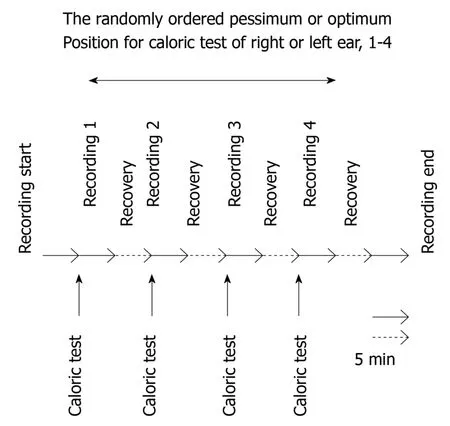
Figure 2 The study design and timeline.Each horizontal arrow is equal to 5 min.
DISCUSSION
These data indicated that despite inducing vestibular stimulation,the 1-s-1-mL ice water caloric test of the right and the left ear had on effect on the short-term HRV indices of cardiac sympathovagal tone in healthy persons.We observed more prolong duration of the nystagmus time in the optimum position.However,the HRV indices had no significant differences following 1-s-1-mL ice water caloric test in the pessimum and the optimum positions.Kasbekaret al[39]reported similar results for a standard bi-thermal caloric test.They used 250 mL of 44 °C and 30°C water for caloric stimulation in a fixed order sequence for the right or the left side in all patients.They report no significant changes in heart rate and blood pressure and concluded that the caloric test in stable cardiac patients had no significant effect on hemodynamic parameters[39].Jauregui-Renaudet al[40]reported changes in HRV indices following caloric stimulation.They used 30 °C water for caloric stimulation during 120 s and also they used only 2 min periods for calculating the frequency domain indices of HRV and despite these setting,they concluded that the increase in HF power was a manifestation of the effect of the caloric test on respiratory frequency[40].We also observed a non-significant increase in the respiratory frequency.It occurred during 5 min interval following 1-s caloric test with 1 mL ice water.But we observed that this effect was more prominent in the optimum position than the pessimum position.
The 1-s-1-mL ice water caloric test caused vestibular stimulation as indicated by inducing the nystagmus.This observation was similar to previous reports[34,37].The caloric test causes vestibular stimulation by indirect and direct mechanisms.The indirect or the main specific mechanism is the endolymph convection and is depended on the head position.The direct or the nonspecific mechanism is due to thermal changes in the activity of vestibular afferents and is independent of the head position.The pessimum position puts the horizontal semi-circular ducts in the horizontal plane and eliminates the effect of gravity on endolymph convection.Therefore,it is used as a type of self-control verification for induction of specific vestibular stimulation;which is only inducible for horizontal semi-circular duct in optimum position.The duration of nystagmus in the optimum position was more than pessimum position in both sides and had significant differences(P<0.01).This finding was expected and indicated a proper vestibular stimulation by the 1-s-1-mL ice water caloric test.
However,the intensity and duration of 1-s-1-mL ice water caloric test were inadequate to elicit a vestibulo-autonomic reflex.The vestibular and the autonomic system may have different sensitivity to caloric stimulation because the vestibular stimulation by 1-s-1-mL ice water caloric test did not provide adequate input for an autonomic output.Many studies reported autonomic effect following vestibular stimulation[18,19,25,27,41]and also many studies reported no autonomic effect following vestibular stimulation[39,42-44].In addition to adequate vestibular input,the effect size of the vestibulo-autonomic reflex must also set appropriate to show its autonomic laterality.Indeed,many factors can be considered as potential sources of inequality of vestibular effects of caloric stimulation between right and left ears.They are the interaural differences in the volume and in the shape of the external ear channels,the variation of co-planarity of semi-circular channels between right and left sides and the laterality in the processing of vestibular inputsper se[22,45-48].

Table 1 The mean±SD of average heart rate and blood pressure(n=12)
The hemispheric dominance of autonomic networks may also cause asymmetric autonomic response following exposure to the one identical stimulus at the right or left side[29-31,49,50].
However,our data did not show any significant differences in short term HRV indices following 1-s-1-mL ice water caloric test on both sides.McGinleyet al[49]reported lateralization only for sympathetic responses.In the same study,they also used a unilateral facial cooling method for selective increase of parasympathetic tone in one-side and recorded its effect on HRV.They observed no differences between right and left side facial cooling stimulation by this method and concluded that despite prominent lateralization for sympathetic activity,there was no parasympathetic lateralization[49].We did caloric vestibular stimulation in the pessimum and the optimum conditions and it may cause some degree of simultaneous cervicosympathetic effect.Boltonet al[51]reported a very complex interaction among cervical proprioception afferents,respiratory muscles,sympathetic tone and vestibular system in cats.However,there are limited data about cervicosympathetic effect on respiration,heart rate and blood pressure in normal humans[52,53].
Our data may provide further clinical support regarding the cardiovascular safety of the 1-s-1-mL ice water caloric test.There is limited data about the safety of different methods of vestibular assessment including the caloric test in cardiovascular patients[39].The research implication of this data is introducing a model for studying the concept of the laterality of vestibulo-autonomic reflex.In contrast to microgravity methods or tilt test,the caloric test can provide specific data because it does not cause hemodynamic compensatory responses due to orthostasis.Therefore,adequate vestibular stimulation by irritation with more volume of cold water or in longer duratione.g.,more than a few seconds may cause different results.
This study had some limitations and any generalization of data need more caution.They included small sample size,visual monitoring of nystagmus and using fixed level of caloric stimulation.Galvanic vestibular stimulations with increasing intensities,measuring the velocity of different phases of nystagmus by electronystagmography and larger sample size can provide better data about cardiac autonomic laterality of vestibular system.
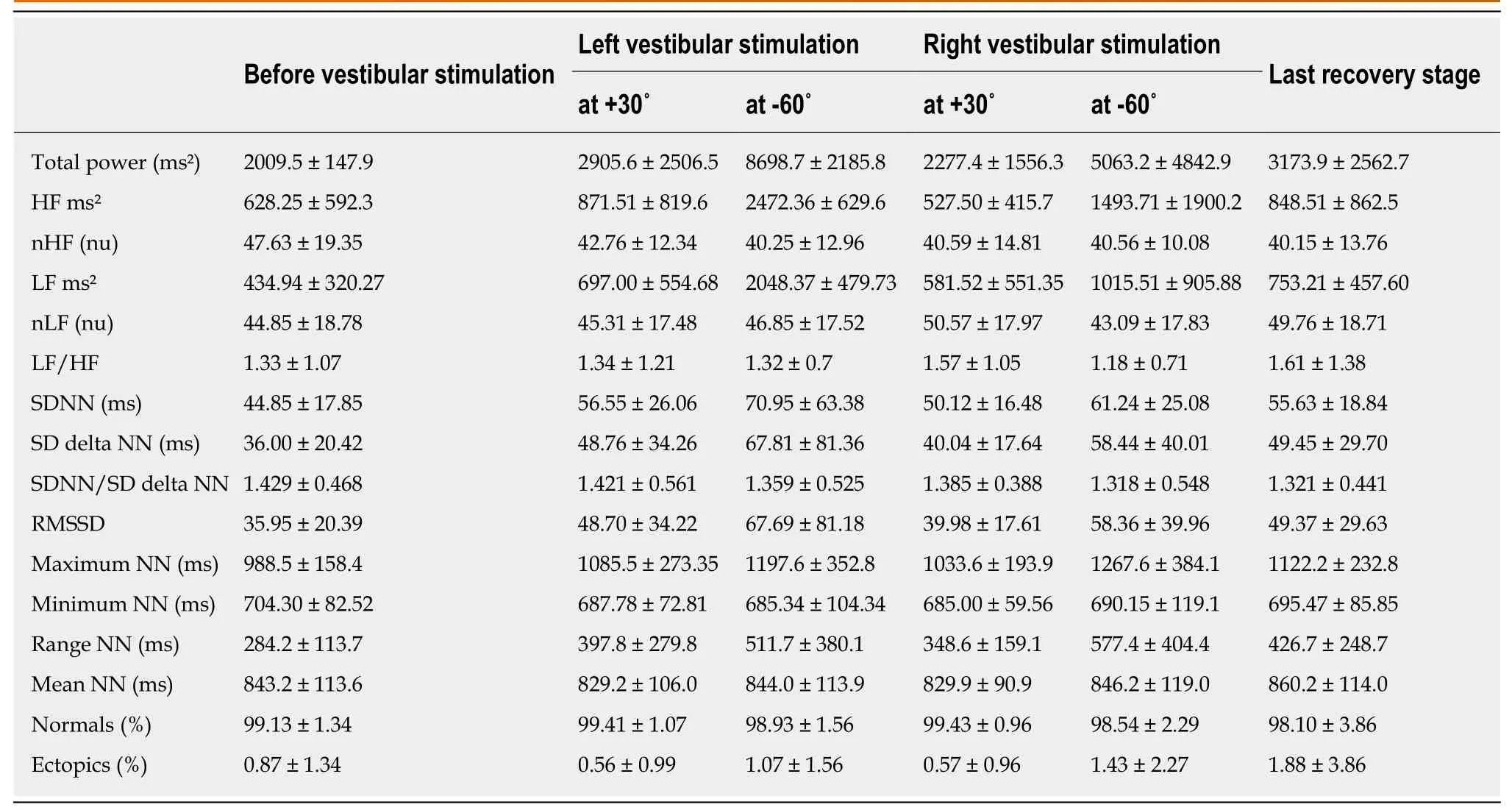
Table 2 The mean±SD of the time and the frequency domain indices of heart rate variability(n=12)
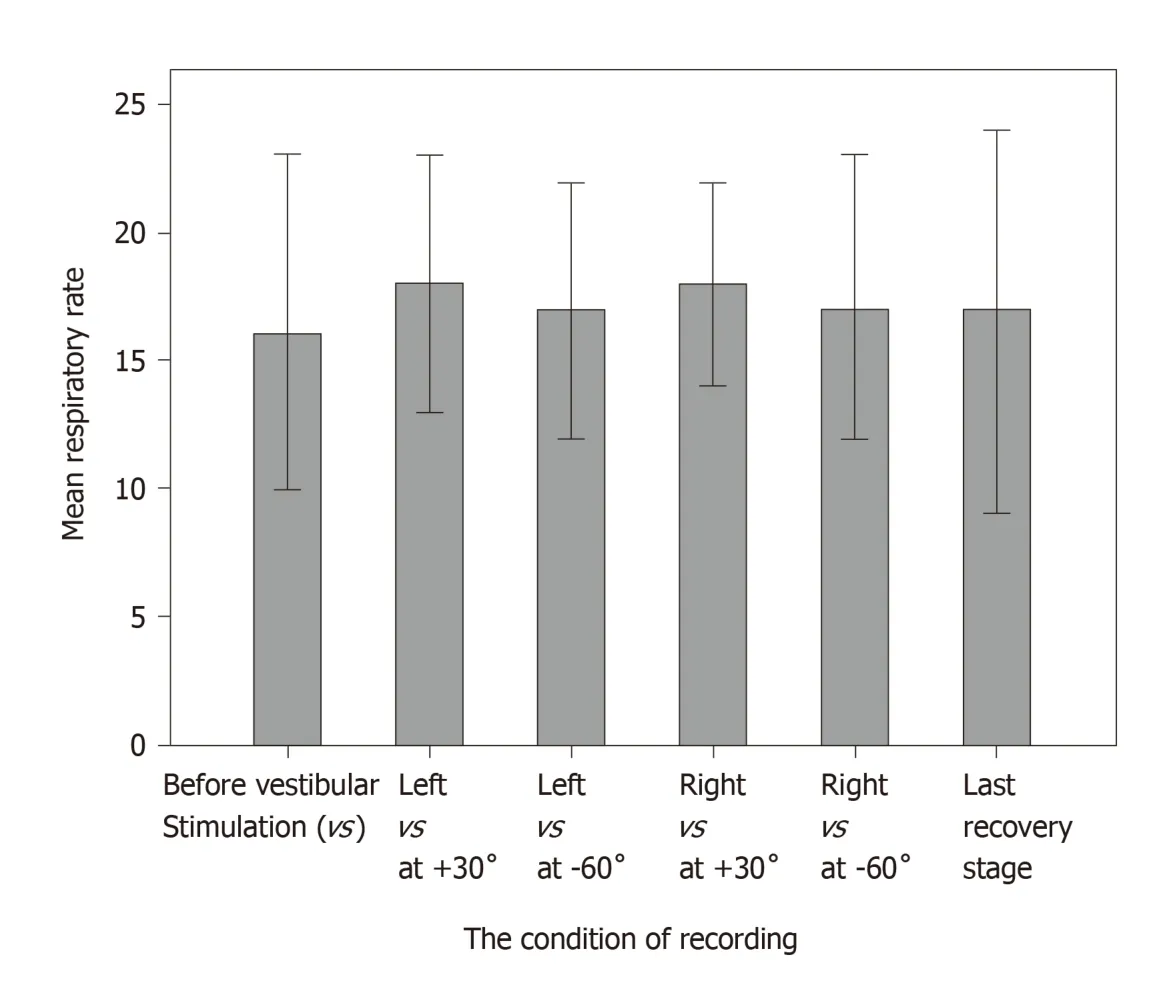
Figure 3 The mean±SD of respiratory rate before vestibular stimulation,after it and following the last recovery stage(n=12).
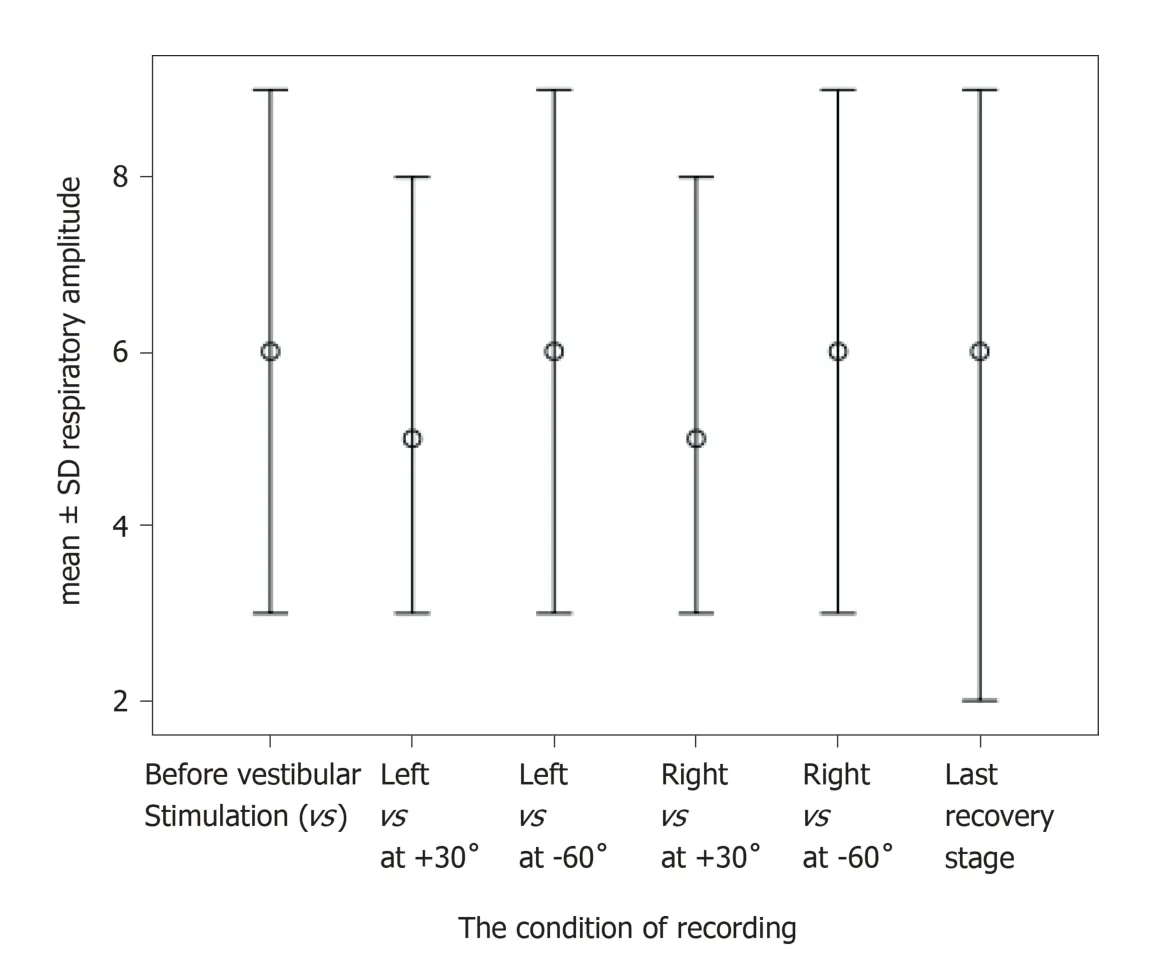
Figure 4 The mean±SD of respiratory amplitude before vestibular stimulation,after it and following the last recovery stage(n=12).
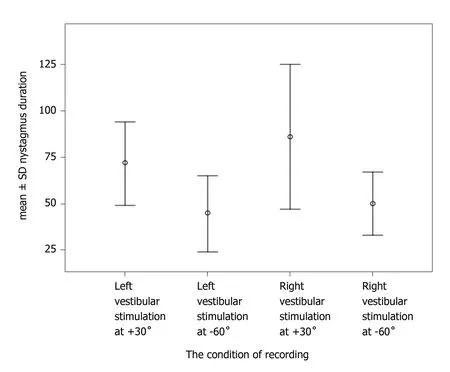
Figure 5 The mean±SD of nystagmus duration in seconds after caloric vestibular stimulation of each ear in the optimum(+30°)and in the pessimum(+60°)conditions(n=12).
ARTICLE HIGHLIGHTS
Research background
The caloric vestibular stimulation provides the opportunity for isolated and unilateral activation of the vestibular system.Therefore,it may be very helpful as a model for comparison of the effect of vestibulo-autonomic reflex on cardiovascular system and for exploration of differences between the right and the left sides.
Research motivation
There is very limited information about the autonomic laterality.The autonomic effects of vestibular system are well documented but the reports about the laterality of vestibular effect on cardiovascular system is rare.
Research objectives
To compare the effect of the caloric test on the cardiac sympathovagal tone and to study any difference between the autonomic effects of the right and the left side caloric vestibular stimulations.
Research methods
This self-control study was conducted on 12 healthy male volunteers.The minimal ice water caloric test was applied for vestibular stimulation in the optimum and in the pessimum positions for each side.The time domain and the frequency domain indices of the heart rate variability were used as markers of cardiac sympathovagal tone.
Research results
Caloric test induced nystagmus and vestibular stimulation in the optimum positions but had no effect on blood pressure,average heart rate and heart rate variability.
Research conclusions
The minimal ice water caloric test was well tolerable,provided inadequate vestibular autonomic stimulation and may have introduced a model for studying the concept of the laterality of vestibulo-autonomic reflex.
Research perspectives
The vestibular and the autonomic system may have different sensitivity to caloric stimulation and the irritation with more volume of cold water or in longer duratione.g.,more than a few seconds may cause adequate autonomic vestibular stimulation.
ACKNOWLEDGEMENTS
The authors wish to thank all volunteers who participated in the study.This study was the result of a Doctor of Medicine Degree thesis.
 World Journal of Cardiology2020年4期
World Journal of Cardiology2020年4期
- World Journal of Cardiology的其它文章
- Role of gut microbiota in cardiovascular diseases
- Do age-associated changes of voltage-gated sodium channel isoforms expressed in the mammalian heart predispose the elderly to atrial fibrillation?
- Comparative assessment of clinical profile and outcomes after primary percutaneous coronary intervention in young patients with single vs multivessel disease
- Subclavian lmpella 5.0 to the rescue in a non-ST elevation myocardial infarction patient requiring unprotected left main rotablation:A case report
